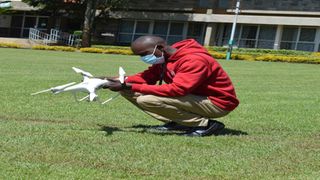
Mr Victor Onyango a member of the Egerton University Njoro Campus Centre of Excellence for Livestock, Innovation and Business (CoELIB) inspecting a drone during the virtual orientation of First Year student at the university on August 31, 2020.
Education
Premium
Varsity’s ventilator model with virtual reality technology boost to Covid war
What you need to know:
- The innovation by Dekut endeavours to use cyber physical technology to control the ventilator.
- The team of innovators is hoping to complete the process of installing the virtual reality.
The year 2020 will go down in history as a tough year that put the entire world to test, courtesy of the corona virus pandemic.
Effects of this virus continue to rock the nations indiscriminately, with the first world countries bearing the brunt of fatalities.
In Kenya, the disruptive effects of the virus continue to be felt. Since the first case was announced in March last year, thousands of citizens have contracted the virus even as the Ministry of Health and other front liners step up to curb its spread.
A part of its effort to join in the fight against Covid-19, innovators at the Dedan Kimathi University of Technology (DEKUT) set out to create a ventilator from scratch.
This was inspired by a spike in demand for ventilators to help patients suffering from respiratory ailments, including corona virus, breathe.
They created a pilot version which was an Ambu bag pneumatic ventilator. It used actuators controlled by compressed air to push oxygen to the patient. This was then upgraded to the Ambu bag electrical ventilators.
“In the second version we created an electric driven Ambu bag, an improvement on our pilot innovation, ” said Prof Bosco, , the project’s lead engineer.
However, it is in the third version that Professor Bosco’s team pride themselves in. In this version, the scientists incorporated the use of Cyber-Physical Systems. They created a prototype of a ventilator that will use virtual reality technology, when accredited, a move that will greatly impact on hospital operations.
Virtual reality is part of the fourth industrial revolution which includes advances in cyber physical spaces, digitisation and blurring the lines between them and the physical lines.
The innovation by Dekut endeavours to use cyber physical technology to control the ventilator and monitor the patients using it. This means that once complete, doctors will be able to monitor their patient’s vitals without necessarily being physically present in the ward.
Using virtual reality
“The intended benefit of using virtual reality is not only to design reviews but also engineer tasks to leading to cost cutting as well as accelerate related processes like virtual commissioning,” Professor Jean Bosco explained.
“The ventilator features two control modes, volume controllers (VC-CMV) and pressure controlled (PV-CMV),” he added.
The team then sought to upgrade and centralise data from different ventilators to one common system. This means that one doctor can receive data from a number of ventilators at the same time in a central position where they can monitor it. This would come in handy especially in Kenya where many hospitals have a shortage of doctors.
“At first, we tested with mannequins before the accreditation by the Kenya Bureau of Statistics (KEBS), Pharmaceuticals and Poisons Board(PPB) and the Ministry of Health (MOH) before we test them out in hospitals,” Prof Bosco said.
Further, the team of innovators is hoping to complete the process of installing the virtual reality which basically means that what was input in the computer would be output by the ventilator while the ventilator could also send a message to the computer on the progress of the patient.
“We want to make it possible for a doctor in Mombasa to treat and monitor a patient in Nyeri. So if the patient is on the ventilator, then the doctor can control the machine. All they have to do is use a laptop and can set the parameters needed depending on the patient,” he said.
“This version we are developing is to master technology so that we can help people. The controls that we use will be locally developed as opposed to that we mostly used imported materials. Currently we have used industrialised controllers which are optimised and noise free,” he added.
“The process of accreditation had been halted due to lack of a ventilator analyser in the country but now we have them and we will resume the work next week,” he added.





